Zenith Trans-Oceanic
H500 Super Trans-Oceanic
1951-1954
 The all-new "Super" Trans-Oceanic H500 introduced in 1951 was a extensive redesign of the Post-WWII Trans-Oceanic. The H500 offered continuous coverage of the shortwave bands from 2mHz to 8mHz, an improvement in coverage of the international shortwave bands over its predecessors. At right is a model H500 Trans-Oceanic I purchased at a pawn shop for $50. The original asking price was $200 (see store's price tag, left, below). I told the owner that $200 was too much for a Trans-Oceanic H500, and offered him $50, but he wouldn't budge on his price. Six months or so later, I stopped in again, and the radio was still there. I again offered him $50, and he said he would take $100 because it was a "working radio." A clerk spoke up and said, "No, it doesn't work. We tried it a few days ago for another customer." The owner said, "Well, I guess you can have it for $50 then." If I had bought the radio on Ebay, I would have paid at least $20 for shipping, so I figure I got it for $30.
.
The all-new "Super" Trans-Oceanic H500 introduced in 1951 was a extensive redesign of the Post-WWII Trans-Oceanic. The H500 offered continuous coverage of the shortwave bands from 2mHz to 8mHz, an improvement in coverage of the international shortwave bands over its predecessors. At right is a model H500 Trans-Oceanic I purchased at a pawn shop for $50. The original asking price was $200 (see store's price tag, left, below). I told the owner that $200 was too much for a Trans-Oceanic H500, and offered him $50, but he wouldn't budge on his price. Six months or so later, I stopped in again, and the radio was still there. I again offered him $50, and he said he would take $100 because it was a "working radio." A clerk spoke up and said, "No, it doesn't work. We tried it a few days ago for another customer." The owner said, "Well, I guess you can have it for $50 then." If I had bought the radio on Ebay, I would have paid at least $20 for shipping, so I figure I got it for $30.
.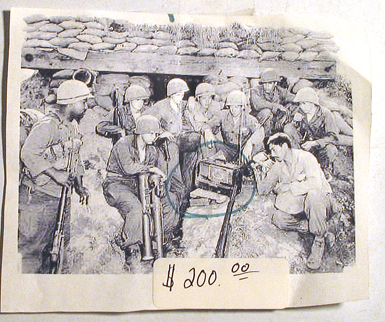 Cosmetically, the radio cabinet is actually in much better condition than it appears. I've done no cleaning on it as of this writing as I'm still working on the 8G005YT. This radio will clean up very nicely. The Black Stag is in good condition. Some black shoe dye and buffing will restore the color and luster. The knobs will get new brass brights and the bail is missing on the front latch, so I've already purchased a replacement for it on Ebay. The original Wavemagnet was warped as if it had been left in the sun, and the one in the photo is a replacement I found on Ebay. The plastic front has one bad crack and several stress cracks, a common problem, caused when the front is removed and the screws are reinstalled too tightly. If I can find a better front for a fair price, I may replace it; otherwise, I will try to fix this one up as best as I can.
Cosmetically, the radio cabinet is actually in much better condition than it appears. I've done no cleaning on it as of this writing as I'm still working on the 8G005YT. This radio will clean up very nicely. The Black Stag is in good condition. Some black shoe dye and buffing will restore the color and luster. The knobs will get new brass brights and the bail is missing on the front latch, so I've already purchased a replacement for it on Ebay. The original Wavemagnet was warped as if it had been left in the sun, and the one in the photo is a replacement I found on Ebay. The plastic front has one bad crack and several stress cracks, a common problem, caused when the front is removed and the screws are reinstalled too tightly. If I can find a better front for a fair price, I may replace it; otherwise, I will try to fix this one up as best as I can.
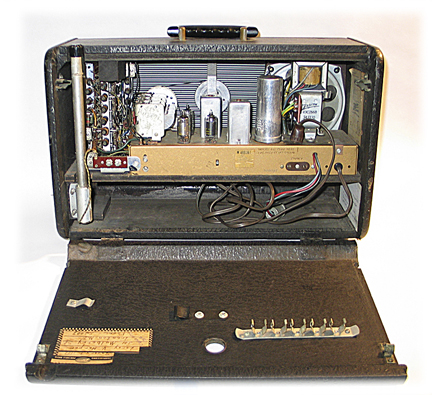
This is quite an interesting radio. When I got the radio home from the pawn shop, the first thing I discovered was an unusual modification to the radio. A tube socket had been added (see photo, below, right)and a 3S4 power output tube installed to replace the original 3V4. Also, the silver can filled with electrolytic capacitors is not original, so the radio has had some repair work done, probably in the 1960's or early 1970's. I pulled all the tubes and tested them and found the 3S4 was bad. I didn't have one, but I did have a 3V4, which I installed in the original socket. I also pulled the good 1L6 tube and replaced it with a 1R5 until I restore the electronics. I then powered up the radio and it came to life instantly, pulling in stations strongly all across the dial.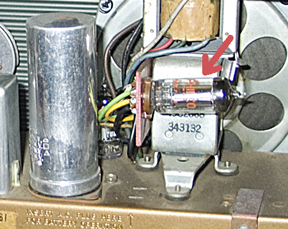 My first thought had been to restore the radio to its original configuration, but after some input from fellow Trans-Oceanic enthusiasts, I may leave the 3SV socket and label, along with the original owners label, as part of the radio's provenance.
My first thought had been to restore the radio to its original configuration, but after some input from fellow Trans-Oceanic enthusiasts, I may leave the 3SV socket and label, along with the original owners label, as part of the radio's provenance.
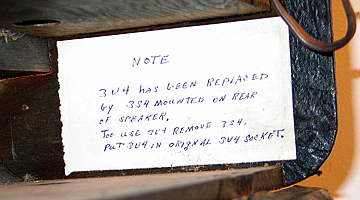
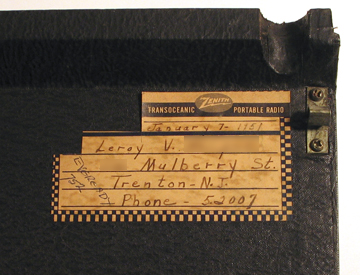
This radio is also interesting because it has the original owners name and address inside the back cover. I've blurred the last name and street number for privacy reasons. The original owner, Leroy ****** was born on September 17, 1913 in Pennsylvania. He worked in a machine shop until he enlisted in the army on Feb. 19, 1941 at Fort Dix, NJ. He died in July, 1977, in Trenton, NJ. I also found an obituary for a lady born in 1946 in Trenton, NJ, who died in December of 2009 in Oklahoma, and whose father had the same name as the original owner, but I haven't been able to confirm that she was his daughter. I don't know how the radio ended up in a pawnshop in Richmond, VA, or who may have ownned it during the intervening years since the original owner passed away.
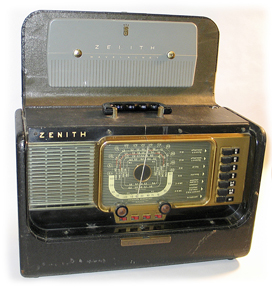
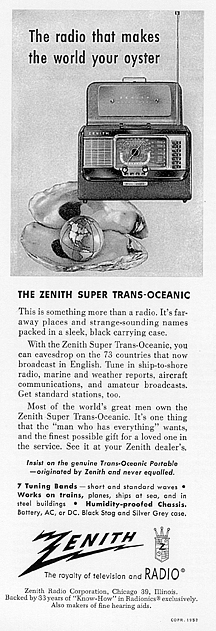 And there's another mystery about this radio, too. What does the date of January 7, 1951 on the owner's label represent? Logically, it would be the date the original owner purchased the radio. But according to Bryant and Cones, authors of Zenith Trans-Oceanic, the Royalty of Radios, the H500 wasn't released until May 31, 1951. So the January, 1951 date is not likely to be the purchase date. One possiblity that has been suggested is that the owner wrote 1951, but meant 1952, a common mistake we've all made after a new year begins.
And there's another mystery about this radio, too. What does the date of January 7, 1951 on the owner's label represent? Logically, it would be the date the original owner purchased the radio. But according to Bryant and Cones, authors of Zenith Trans-Oceanic, the Royalty of Radios, the H500 wasn't released until May 31, 1951. So the January, 1951 date is not likely to be the purchase date. One possiblity that has been suggested is that the owner wrote 1951, but meant 1952, a common mistake we've all made after a new year begins.
Although there is only one chassis, 5H40, and one model of the H500, there are at least five reported variations of the 5H40 chassis. Early versions had a dual pin headphone jack. The later versions used a 1/4" phono plug. The earliest Model H500 sets used a 1S5 tube for the detector/AVC/AF. Shortly after its introduction, the chassis was modified to use a 1U5 tube in place of the 1S5. This set has the 1U5 and dual pin headphone plug, making it an early revised model. The speaker's source/date code indicates it was made the week of August 6-10, 1951, so this radio was probably made not too long after that, as Zenith tied inventory to production to avoid large inventories of parts. More H500 Trans-Oceanics were made than any of the other models, and they are still readily available. Many collectors like the H500 because of the airplane style dial in the contemporary front, which it shares with the 600 series radios.
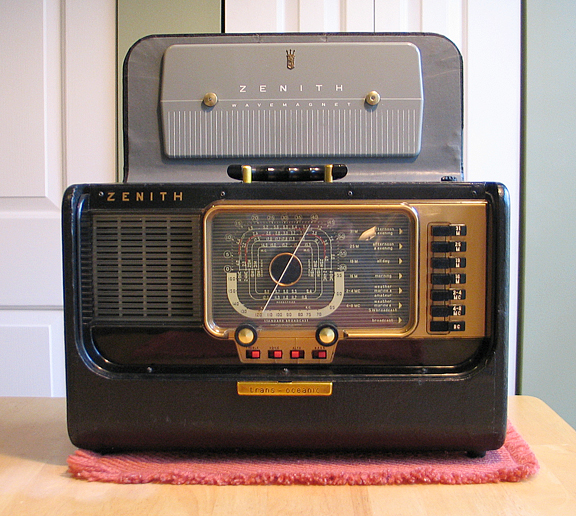 Restoration is now finished on this radio. It has been recapped and aligned. New faceplate and knob brights along with some black shoe dye and polish on the cabinet make it look almost brand new.
Restoration is now finished on this radio. It has been recapped and aligned. New faceplate and knob brights along with some black shoe dye and polish on the cabinet make it look almost brand new.
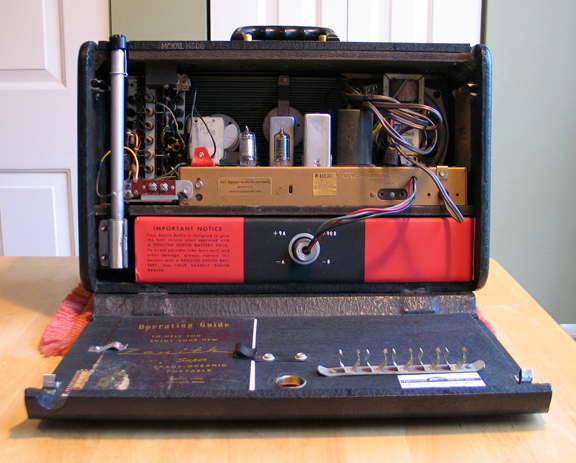
Download a free Restoration Guide for 500 and 600 series Trans-Oceanic radios



 Cosmetically, the radio cabinet is actually in much better condition than it appears. I've done no cleaning on it as of this writing as I'm still working on the 8G005YT. This radio will clean up very nicely. The Black Stag is in good condition. Some black shoe dye and buffing will restore the color and luster. The knobs will get new brass brights and the bail is missing on the front latch, so I've already purchased a replacement for it on Ebay. The original Wavemagnet was warped as if it had been left in the sun, and the one in the photo is a replacement I found on Ebay. The plastic front has one bad crack and several stress cracks, a common problem, caused when the front is removed and the screws are reinstalled too tightly. If I can find a better front for a fair price, I may replace it; otherwise, I will try to fix this one up as best as I can.
Cosmetically, the radio cabinet is actually in much better condition than it appears. I've done no cleaning on it as of this writing as I'm still working on the 8G005YT. This radio will clean up very nicely. The Black Stag is in good condition. Some black shoe dye and buffing will restore the color and luster. The knobs will get new brass brights and the bail is missing on the front latch, so I've already purchased a replacement for it on Ebay. The original Wavemagnet was warped as if it had been left in the sun, and the one in the photo is a replacement I found on Ebay. The plastic front has one bad crack and several stress cracks, a common problem, caused when the front is removed and the screws are reinstalled too tightly. If I can find a better front for a fair price, I may replace it; otherwise, I will try to fix this one up as best as I can. The all-new "Super" Trans-Oceanic H500 introduced in 1951 was a extensive redesign of the Post-WWII Trans-Oceanic. The H500 offered continuous coverage of the shortwave bands from 2mHz to 8mHz, an improvement in coverage of the international shortwave bands over its predecessors. At right is a model H500 Trans-Oceanic I purchased at a pawn shop for $50. The original asking price was $200 (see store's price tag, left, below). I told the owner that $200 was too much for a Trans-Oceanic H500, and offered him $50, but he wouldn't budge on his price. Six months or so later, I stopped in again, and the radio was still there. I again offered him $50, and he said he would take $100 because it was a "working radio." A clerk spoke up and said, "No, it doesn't work. We tried it a few days ago for another customer." The owner said, "Well, I guess you can have it for $50 then." If I had bought the radio on Ebay, I would have paid at least $20 for shipping, so I figure I got it for $30.
.
The all-new "Super" Trans-Oceanic H500 introduced in 1951 was a extensive redesign of the Post-WWII Trans-Oceanic. The H500 offered continuous coverage of the shortwave bands from 2mHz to 8mHz, an improvement in coverage of the international shortwave bands over its predecessors. At right is a model H500 Trans-Oceanic I purchased at a pawn shop for $50. The original asking price was $200 (see store's price tag, left, below). I told the owner that $200 was too much for a Trans-Oceanic H500, and offered him $50, but he wouldn't budge on his price. Six months or so later, I stopped in again, and the radio was still there. I again offered him $50, and he said he would take $100 because it was a "working radio." A clerk spoke up and said, "No, it doesn't work. We tried it a few days ago for another customer." The owner said, "Well, I guess you can have it for $50 then." If I had bought the radio on Ebay, I would have paid at least $20 for shipping, so I figure I got it for $30.
.
 My first thought had been to restore the radio to its original configuration, but after some input from fellow Trans-Oceanic enthusiasts, I may leave the 3SV socket and label, along with the original owners label, as part of the radio's provenance.
My first thought had been to restore the radio to its original configuration, but after some input from fellow Trans-Oceanic enthusiasts, I may leave the 3SV socket and label, along with the original owners label, as part of the radio's provenance.


 And there's another mystery about this radio, too. What does the date of January 7, 1951 on the owner's label represent? Logically, it would be the date the original owner purchased the radio. But according to Bryant and Cones, authors of Zenith Trans-Oceanic, the Royalty of Radios, the H500 wasn't released until May 31, 1951. So the January, 1951 date is not likely to be the purchase date. One possiblity that has been suggested is that the owner wrote 1951, but meant 1952, a common mistake we've all made after a new year begins.
And there's another mystery about this radio, too. What does the date of January 7, 1951 on the owner's label represent? Logically, it would be the date the original owner purchased the radio. But according to Bryant and Cones, authors of Zenith Trans-Oceanic, the Royalty of Radios, the H500 wasn't released until May 31, 1951. So the January, 1951 date is not likely to be the purchase date. One possiblity that has been suggested is that the owner wrote 1951, but meant 1952, a common mistake we've all made after a new year begins. Restoration is now finished on this radio. It has been recapped and aligned. New faceplate and knob brights along with some black shoe dye and polish on the cabinet make it look almost brand new.
Restoration is now finished on this radio. It has been recapped and aligned. New faceplate and knob brights along with some black shoe dye and polish on the cabinet make it look almost brand new.
